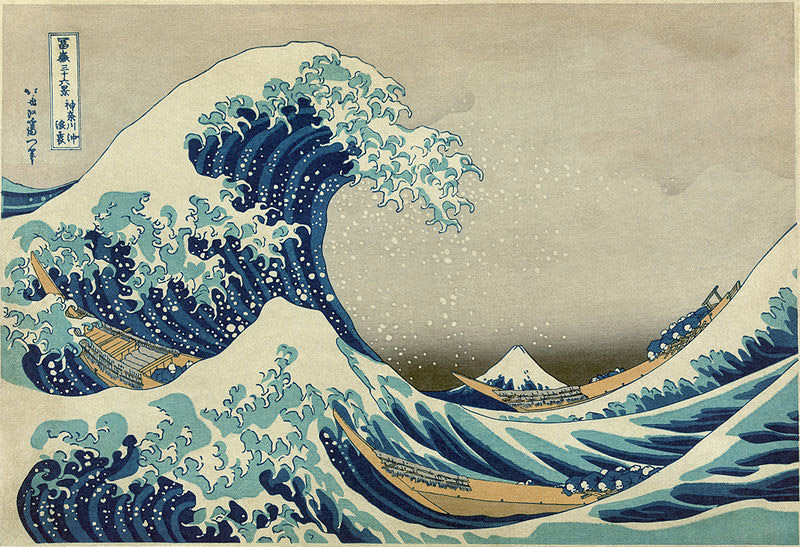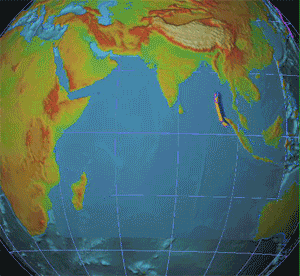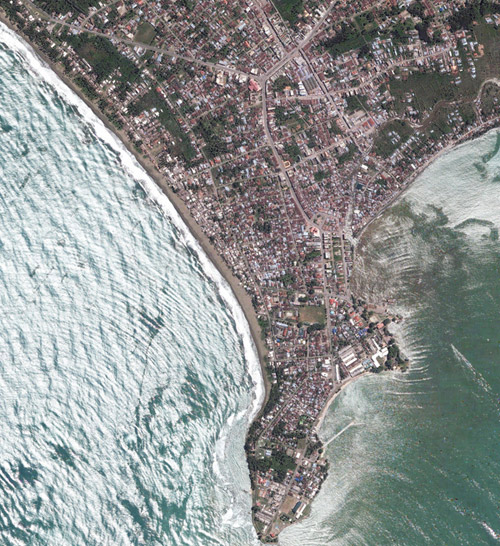Lesson: The Great Wave

(Lesson courtesy the United Nations Educational, Scientific and Cultural Organization (UNESCO) and Discovery Education). Grade Level: 6-8. Time required: Two class periods. Group size: 3-4 students
Overview
A tsunami races through the ocean deep at jet-aircraft speed. Approaching the shore, it can crest to more than 100 feet, hitting coastal areas with devastating force. In this package of lessons and activities, students will learn what causes a tsunami, the physics behind its movement, and how scientists know when one is forming. They can also study its impact on a model town, view tsunami-resistant house designs and learn about a 10-year-old girl credited with saving dozens of lives when a tsunami struck Samoa.
Learning Objectives
- Discover the causes of tsunamis in oceans and fjords.
- Learn that tsunamis in oceans and fjords can create great surges that cause much destruction.
- Learn why ocean tsunamis and fjord tsunamis behave differently.
Standards
National Standards:
- Earth and Space Science: Structure of the earth system
- Physical Science: Motions and forces; Transfer of energy
- Science in Personal and Social Perspectives: Natural hazards; Risks and benefits
Mid-continent Research for Education and Learning (McREL):
- Science, Physical Science: Understands the sources and properties of energy.
- Science, Earth Science: Understands Earth’s composition and structure.
- Geography, Physical Systems: Knows the physical processes that shape patterns on Earth’s surface.
The National Council for the Social Studies thematic standards:
- People, Places, and Environments
- Individuals, Groups, and Institutions
- Power, Authority, and Governance
- Science, Technology, and Society
Vocabulary
Tsunami: A series of catastrophic ocean waves generated by undersea earthquakes or landslides, volcanic eruptions, or the impact of a large meteorite in the sea. Context: The word “tsunami” comes from the Japanese term for great harbor wave.
Crest: The top of a wave. Context: The crest of a wave may rise only a foot or two above normal.
Fjord: A narrow sea inlet between cliffs or steep slopes. Context: The falling ice creates a wave that spreads rapidly across the fjord.
Surge: A large wave or billow. Context: The water builds and then breaks into a huge surge that rushes ashore.
Trough: The lowest point between waves. Context: For every wave peak is a trough. If the trough appears first, the sea recedes before a wave arrives on land.
Background
Tsunamis are gigantic waves that come ashore with little or no warning. A tsunami is caused by earthquakes or volcanoes that move the land on the bottom of the ocean. Movement of the earth’s land is called an earth tremor. When a tremor shakes the land under the sea, it causes the water at the surface to rise up in a hump. This high swell of water starts moving away. After a long trip, this swell finally reaches shore. It roars onto the beach as a wave. This tsunami wave can be a wall of water 7 meters (21 feet) to 33 meters (100 feet) high.

The name tsunami comes from two Japanese words. Tsu means “port” and nami means “wave.” Many tsunamis hit the coasts of the Japanese islands. To understand why, look at Japan on a world map. Its eastern and southern coasts face the whole Pacific Ocean. A tsunami can form far away in the southern or eastern Pacific. It starts moving towards Asia and builds up size and speed as the tsunami heads west. For thousands of miles, there is no land to stop it or slow it down. Then it hits the coast of Japan. This is why Japan has more tsunamis than anywhere else in the world.
Today scientists have more warning that a tsunami is forming. They can find earthquakes under the ocean using a machine called a seismograph. Also, photos taken from airplanes and images taken by space satellites show ocean waves. Scientists send early warnings to port cities that a big wave is on the way. See a factsheet and find out what government research can tell us. Read a typical tsunami alert message.
In late September, a severe earthquake struck off American Samoa, triggering a series of tsunamis that killed more than 180 people and flattened villages in Samoa and Tonga, according to news reports. Even more people might have died had it not been for 10-year-old Abby Wutzler, who had been taught tsunamis at school. She ran along the beach telling people to head for higher ground. See video.
The Physics of a Tsunami
Earthquakes generate tsunamis when the sea floor abruptly deforms and displaces the overlying water from its equilibrium position. Waves are formed as the displaced water mass, which acts under the influence of gravity, attempts to regain its equilibrium. The main factor that determines the initial size of a tsunami is the amount of vertical sea floor deformation. This is controlled by the earthquake’s magnitude, depth, fault characteristics and coincident slumping of sediments or secondary faulting. Other features which influence the size of a tsunami along the coast are the shoreline and bathymetric configuration, the velocity of the sea floor deformation, the water depth near the earthquake source, and the efficiency which energy is transferred from the earth’s crust to the water column. Read more.

Materials
For each group:
- Two plastic containers with the same lengths but different widths; one should be significantly narrower.
- Water
- Small rock, ball of clay, or other object to drop in the containers
- Ruler or tape measure
Procedure
Introduction
1. Review what students know about tsunamis. Discuss the causes of a tsunami: undersea earthquakes or landslides, volcanic eruptions, or the impact of a large meteorite in the sea. Tell students that a tsunami can also occur in a fjord, a narrow ocean inlet surrounded by cliffs. Portions of icebergs breaking, or calving, into the water can cause a fjord tsunami.
2. Next, tell students they will perform an experiment to discover how calving icebergs can create different wave patterns in the ocean and in a fjord. Before the experiment, students should write a hypothesis about how wave patterns might differ in the two environments.
Activity
1. Divide the class into groups and distribute materials to each group. Ask students to consider how they will use these materials to test their hypotheses. Remind them that water depth should not be a factor in their experiments; they should consider the widths of water in an open ocean and in a fjord. (The wider plastic container represents the ocean, the narrow container represents a fjord, and the small object represents the calving iceberg.)
5. Have students fill each container with water, using the ruler to make sure that the depth is the same in both containers.
6. Next, students will drop an object from the same height into each container and observe the resulting wave patterns. Have students record their results.
7. Hold a class discussion about the experiment. Ask how they know that the difference in wave pattern was not due to differences in water depth. Have students hypothesize in which environment a calving iceberg might cause a greater ocean surge.
8. Have each student draw a diagram showing the results of the experiment. A brief paragraph should describe each diagram.
9. Hold a discussion to compare the effects of fjord tsunamis as a result of a calving iceberg and ocean tsunamis that are the result of an underwater earthquake.
Discussion Questions
1. Why do tsunamis occur more frequently in the Pacific Ocean than in the Atlantic or Indian Oceans?
2. Describe how tsunamis affect people who do not live on a coastline.
3. Do you think it is possible to make architectural changes that can protect a beachfront home from a tsunami?
Assessment
Use the following three-point rubric to evaluate students’ work during this lesson.
3 points: Students’ created carefully executed diagrams that clearly showed the experiment’s results; wrote clear, accurate, and error-free descriptive paragraphs.
2 points: Students created diagrams that somewhat clearly showed the experiment’s results; wrote satisfactory descriptive paragraphs that included some errors.
1 point: Students created unclear diagrams; wrote vague descriptive paragraphs that included numerous errors.
Extensions
- Have students research the house designs engineers have come up with to resist tsunamis. Look at this website to see what a group of engineers from Harvard and MIT are doing. Have them write a paragraph describing the building and what makes it unique.
- Assign students to research recent tsunami disasters. How well or badly did structures survive? What efforts were made by engineers to aid survival and recovery?
- Have students read Prism magazine’s September 2009 article “Emergency Response,” which describes the work of engineers who aid in disasters.
Resources
- The Tsunami page of NOAA (National Oceanic and Atmospheric Administration)
- ITIC, International Tsunami Information Centre. Updated January 17, 2006. U.S. National Weather Service, NOAA. Accessed March 1, 2006. http://www.tsunamiwave.info/
- A related eGFI lesson and activity, Tsunami Structure Survival, with more detailed background on tsunamis.
Filed under: Grades 6-8, Lesson Plans
Tags: Environmental Engineering, Grades 6-8, Ocean








